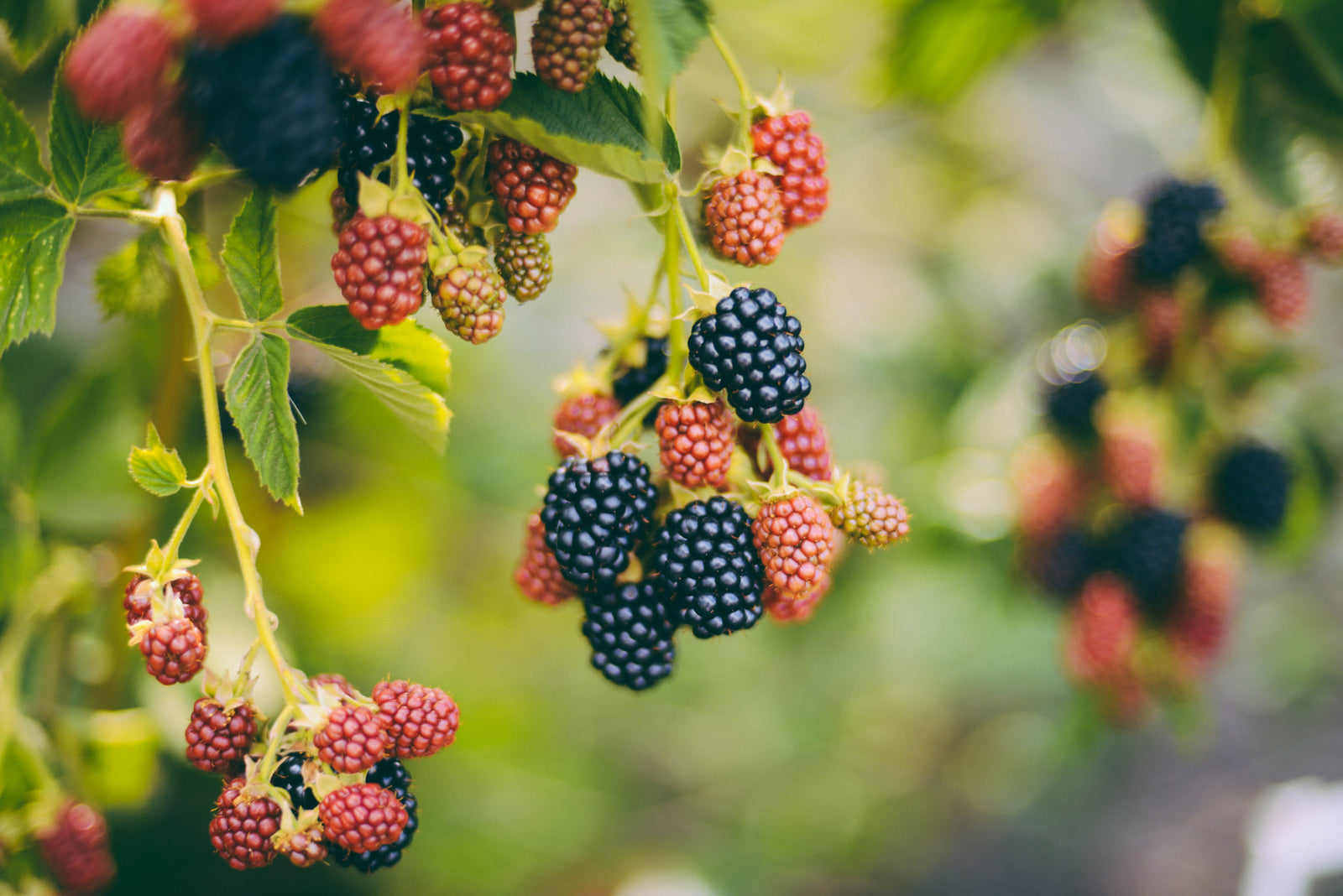
QUICK ANSWER
Top Fruit Trees to Grow in San Diego
It's always fun to create your own mix of your family's favorite fruits. Below are some fruit tree varieties that can thrive in San Diego's climate:
- Citrus (oranges, lemons, grapefruit, limes, etc.)
- Avocado
- Certain stone fruit varieties (peaches, nectarines, etc.)
- Fig
- Persimmon
- Pomegranate
- Loquat

A COMPARISON
GROWING FRUITS IN SAN DIEGO
|
Variety
|
Harvest Season |
Time to Produce
|
Spacing
|
| Citrus | Varies year-around |
3 years | 12-15ft for standard trees (half for dwarf varieties) |
| Avocado | Spring-early fall |
3-5 years (when planted as a young tree) | 10ft from buildings, 20-30ft from other large fruit trees |
| Stone Fruit | Late spring-early fall | 2-5 years | 10-20ft |
| Fig | Mid summer-early fall | 3-5 years | 12-20ft |
| Persimmons | Fall-winter | 5-7 years | 10-20ft |
| Pomegranate | Fall-winter | 5 years | 15ft |
| Loquat | Spring-early summer | 3 years (when planted as a young tree) | 15ft, 8-10ft for dwarf varieties. |
THE DETAILS:
- Nothing says "California garden" like a yard scented with orange blossoms and trees full of juicy limes waiting to be included in your favorite Mexican dish. Citrus trees are a classic choice for San Diego homeowners. If you're short on space, you can plant dwarf citrus trees in containers with a cactus mix. Citrus trees grow best in full sun and sandy, moist, well-draining soil. If you have heavy clay soil, you can amend it or plant the tree on a mound to keep the roots elevated. The key is to make sure the roots do not stay soaked.
- Avocado trees are another classic choice for Southern California gardens. The main things an avocado needs are rich soil, excellent drainage, and a thick layer of mulch over the roots. Allow fallen leaves to remain under the tree; don't rake them up. (Avocados are best planted at the back of the garden where their large leaves won't look too messy.) Add additional mulch to young trees. Avocados have a number of other special growing needs, so be sure to take a look at some of our avocado-specific online resources.
- Stone fruit is a category that includes peaches, plums, nectarines, and apricots. When it comes to growing our favorite summer fruits, it’s important to find varieties that have a low requirement for “chill time.” Since our winters are quite mild, look for varieties that need fewer than 500 chill hours (hours when the temperature dips below 45 degrees in the earlier part of winter). Plant stone fruit trees in maximum sunlight, and thin excess fruit toward the tips of the branches. When watering your fruit trees, keep the soil moist but not soaked.
- Figs are not only delicious, but these attractive trees also make a beautiful addition to your landscape. They prefer warmth, so be sure to find a sunny spot in your yard to plant a fig tree. For those who live toward the coast, the best varieties are White Genoa, Black Mission, Celeste, and Conadria. Inland San Diego gardeners can plant any of these as well as Black Jack and Kadota figs. You can expect larger harvests in just a few years after planting.
- Persimmons come in two main types: non-astringent (Fuyu, Izu, Jiro, Suruga) and astringent (Hachiya, Saijo, Honan Red). Non-astringent persimmons are firm in texture, and they can be eaten straight off the tree. Astringent varieties must be fully ripe (almost mushy) in order to be used. They can be eaten fresh, but most prefer to bake with this type. Like most of the other fruits we’ve mentioned, persimmons like sun and well-draining soil. It’s a good idea to prune your persimmon tree early on in order to encourage the growth of a few strong main branches.
- Pomegranates grow on a shrub rather than a tree, but their beautiful ruby-red seeds are a delicious addition to salads and juices (or on their own!) through the fall and winter months. They take a bit longer to mature (5-7 years), but a big advantage is their low water requirement.
- Loquats are frequently seen in San Diego landscapes. If you’ve never had a loquat before, it’s similar to a mild, juicy apricot. These trees require little water once established, so they are great for a drought-tolerant garden. When planting, keep in mind that they drop a lot of leaves; pick a spot in your yard where this won’t be an eyesore. If you purchase a young tree from the nursery, you can expect to harvest delicious fruit in spring and early summer after two or three years.
FRUIT TREES 101
Special care tips for different fruits

Now that you've selected your favorite fruits to include in your garden, here are some additional care tips for specific types of trees:
1. DORMANT SPRAYING
Dormant spraying helps to keep destructive insect populations as well as potentially deadly fungal infections under control. Dormant spray should be applied to all deciduous trees and shrubs which had insect infestations or disease during the prior year. This is especially important for deciduous fruit trees and roses.
Dormant oil spraying should be done on a clear day with minimal breeze, ideally when the temperature is between 40 and 70°F. It is best if the temperature remains over 50°F for at least 24 hours to allow complete coverage, which is essential for controlling pests effectively. Apply spray with a pump sprayer or a hose-end sprayer twice a year: in late November or early December when all the leaves have fallen, and in early February before buds begin to swell. It is especially recommended to spray at both of these times if the infestation or disease was bad during the previous season.
For insect control, use spray oil. This oil will smother insect eggs over-wintering in the same places as the fungal spores. This product can be mixed together with Copper Fungicide (Monterey® Liqui-Cop) for excellent control of insects and disease.
2. PRUNING
All deciduous fruit trees need to be pruned at least once a year for good shape and to bear fruit. The time to do major pruning is during the winter—while the trees are dormant, after the leaves have fallen to the ground but before new buds have swelled (generally January).
Each type of fruit tree needs to be pruned differently. For example, apples bear their fruit on spurs that bear again and again, sometimes for as long as twenty years. If you whack off all the spurs you’ll have no fruit. However, peaches and nectarines bear their fruit on one-year-old wood. By pruning them hard every year, you encourage new growth to replenish fruiting wood.
Ideal shaping also differs among types. Apple and pear trees, for instance, do best with a central trunk, with shorter branches at the top, longer ones on the bottom. Peaches and plums do best with an open-center shape (kind of like a bowl).
As evergreens, citrus trees do not need the hard pruning that deciduous trees do. For citrus, trim away suckers and any midsize branches that block airflow (look for branches that grow straight up through the middle of the tree).
3. PROTECTING CITRUS FROM FROST
Even in San Diego, we do experience an occasional frost during wintertime. This can be particularly damaging to citrus, so here are some tips for keeping your tangy fruit trees frost-free:
- Make sure plants are well-watered.
- Harvest any fruit that is ripe. Unripened citrus will not mature after being picked—just leave unripened fruit on the tree.
- For citrus trees under three years old, wrap a thick insulating material such as burlap sheets or Dewitt® N-Sulate Blankets around the tree trunk.
- If the citrus plant is in a container, move it to an area that shelters it from the wind. Against a sunny, south- or west-facing brick wall is ideal, as the brick absorbs heat during the day and releases it when the sun goes down.
- Pull aside any existing mulch. The warm soil will send heat back up through the tree.
- You can even hang a string of the larger-bulbed Christmas lights in the central area of the tree to add a few degrees of warmth.
- Cover plants with burlap, row cover fabric or cloth sheets, but be sure to remove them during the day.
By keeping your trees warm and protected during the winter months, you can ensure that the frost will not spoil your citrus harvest.
---
 Fruit trees are always a rewarding addition to the garden, and there are so many delicious types that the San Diego homeowner can grow and enjoy. Now that you know some of the best varieties to plant, you can start planning to add your favorites to your landscape. Fruit tree care and maintenance can be a challenge to most amateur gardeners, so we encourage you to look at our more detailed fruit tree resources online, and the garden professionals at your local Grangetto’s are always happy to help you troubleshoot any obstacles you encounter.
Fruit trees are always a rewarding addition to the garden, and there are so many delicious types that the San Diego homeowner can grow and enjoy. Now that you know some of the best varieties to plant, you can start planning to add your favorites to your landscape. Fruit tree care and maintenance can be a challenge to most amateur gardeners, so we encourage you to look at our more detailed fruit tree resources online, and the garden professionals at your local Grangetto’s are always happy to help you troubleshoot any obstacles you encounter.



